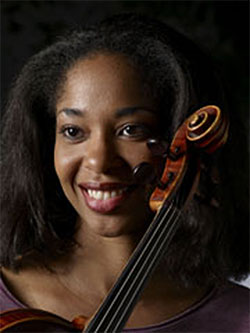by Mike Telin

On Sunday, April 28 in Pilgrim Church, Eliesha Nelson and pianist James Howsmon presented a captivating recital that featured works by two lesser known composers as well as a household name on the final concert of Arts Renaissance Tremont’s season.
Nelson referred to the programming of the first half as “a homage to 20th Century American Music.” Composer Ross Lee Finney (1906 – 1997) was a student of Nadia Boulanger, Edward Burlingame Hill and Alban Berg as well as Roger Sessions and served on the faculties at Smith and the University of Michigan. His Second Viola Sonata (1971), Nelson told the large audience, was a serial composition. Although the term serial music can often instill uneasy feelings, Finney’s 15-minute, four-movement work is a surprisingly melodic gem. The opening Andante, teneramente, is quite lyrical and Permutations is full of playful musical interchanges. The dark and meditative Largo, teneramente and the concluding Allegro con moto were a joy to listen to. Throughout both, Nelson and Howsmon performed with technical command and musical sensitivity.
Ukrainian composer Nikolai Kapustin (b. 1937) studied piano at the Moscow Conservatory and later developed a reputation as a jazz pianist, arranger and composer (jazz being the American part) and his Viola Sonata, Op. 69 (1992) is clearly jazz-inspired. Nelson also noted that Kapustin has never bothered to publish the piece, but thanks to technology the parts were scanned and e-mailed to her. Thankfully for the listener, Nelson persisted, because this is a fun piece to listen to as well as watch. The opening Allegro, defined by running bass lines in the piano grabs your attention and Nelson sounded beautiful during the introspective song of the middle Largo. The final Vivace begins with a bass line groove and eventually turns into a jazzy perpetual motion. Nelson again tossed off the difficult technical passages with ease and Howsmon displayed some virtuoso pianism without breaking a sweat.
The second half of the program was dedicated to a single work, Franz Schubert’s Sonata in A minor, D. 821, Arpeggione. Composed in 1824, the work is the only remaining composition of note written for the arpeggione, a six-string fretted, bowed guitar and the three-movement piece is quintessential Schubert. Throughout, Nelson became a vocalist allowing the melodic line to sing without ever sounding strained. Howsmon was as he always is, a sensitive collaborator. In short, it was twenty minutes of listening pleasure.
For 22 seasons Arts Renaissance Tremont has been presenting engaging programs by talented musicians and we look forward to seeing what’s in store for season 23. Great music at no cost in beautiful space, what could be better?
Published on ClevelandClassical.com May 7, 2013
Click here for a printable version of this article.



